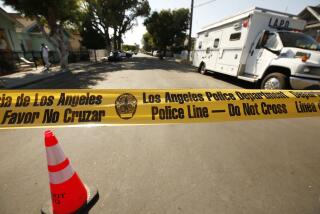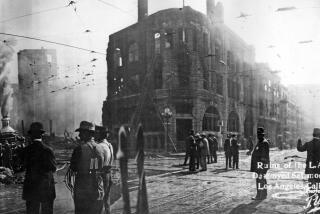2 Had Forecast Gas Attack on Subway : Japan: A U.S. expert on chemical warfare and a British novelist take no pleasure in their accuracy.
- Share via
TOKYO — While the subway nerve gas attack last week caught most people here by surprise, there were eerily prescient warnings of the deadly incident, alarms more specific than, say, the prophecy of a rival religious leader that Aum Supreme Truth was a dangerous sect.
The prognosticators now attracting key attention--for very different reasons--include a novelist, Gordon Thomas, and a chemical warfare expert, Kyle Olson.
Thomas envisioned his lethal scenario based on imagination; Olson was dealing with a real and fatal case. Neither takes any pleasure in the accuracy of his forecasts, and both raise questions, in hindsight, about why Japanese authorities may not have been more forthcoming in sharing their fears.
Olson, executive vice president of the nonprofit Chemical and Biological Arms Control Institute in Virginia, came to Japan in December to investigate a little-discussed toxic poisoning case: One night last June in Matsumoto, about 100 miles west-northwest of Tokyo, pets keeled over, 200 people fell ill and seven died after a mysterious vapor passed through a neighborhood.
Police and newspapers called the case an accident. Olson disagreed.
“There is compelling evidence . . . the events in that quiet city were anything but accidental,” he wrote after a week’s analysis in Matsumoto. “It is not far-fetched to postulate a small group of persons were . . . carefully testing and evaluating the effectiveness of a weapon based on a technology with which they are unfamiliar.”
He theorized that the incident was a rehearsal for a larger gas attack in “a warm, crowded urban site such as a Ginza department store or major subway station.”
While analysts puzzled over the Matsumoto incident, no one took responsibility for it, leading some to believe there was no organized group behind it.
But the absence of demands or political statements made Olson think, “There are terrorists, they have a weapon, and they’re still out there waiting.”
His report captured the attention of the CIA, the National Security Council and the Defense Department, which were concerned about the potential danger for other areas, he said.
But the Japanese government seemed uninterested when presented with the conclusions. “They said, ‘It’s a local matter for the police in Matsumoto,’ ” said Olson, who was surprised then by the official diffidence.
But analysts--and now even Olson--said the seeming indifference may have been a ruse by Japanese police allowing them to conduct their own investigation and deflect attention from it.
He was not surprised when he heard about the March 20 Tokyo attack, which killed 10 commuters and injured more than 5,000. “The subway system was a target too rich to pass up: There’s a tremendous number of people in an enclosed space, and it has tremendous symbolic value.”
As for Thomas, when the British novelist wrote his thriller, he hoped it would make a good movie script: A band of religious fanatics procures a lethal poison gas and, after a test strike on a small town, plans to release it into the subway system in international capitals.
The plot’s uncanny resemblance to events in Tokyo has some wondering if the 4-year-old novel may have been a script for terrorists. “The book is completely sold out,” said a clerk at a large Tokyo bookstore, Kinokuniya. “The similarities with (the March 20) incident are so close it’s uncomfortable.”
In “Deadly Perfume,” Thomas has terrorists wipe out a small town in South Africa as a rehearsal for their ultimate global attack. Almost nobody notices.
The novel’s hero, David Morton, thwarts the villains before they can carry out their plan. Unfortunately, Japan didn’t have such a savior. The leader of Aum Supreme Truth, the group at the center of suspicion in the nerve gas attack, has fled, leaving Japanese anxiously wondering what’s going to happen next in their real-life drama.
“It doesn’t give me any pleasure that the book predicted what happened,” Thomas said in a telephone interview from Delgany, Ireland, rejecting rumors that pages from his book were found in Supreme Truth’s headquarters. “The coincidences are indeed uncanny, but to me, it was an accident waiting to happen.”
Thomas, 62, a former journalist, drew from friends in the intelligence community and his experience covering news events from the Cold War to the Persian Gulf War to Tian An Men Square for his other 35 novels and nonfiction books.
The inspiration for “Deadly Perfume,” he said, was a 1950s incident in which the CIA released a harmless powder dye in the New York subway system to see how a bacterial or chemical agent would spread. In minutes, it reached nine stations, covering commuters with the special dust, which they assumed to be typical New York grime. “The idea appealed to me,” he said. “I wanted a delivery system that would reflect everyday life. There’s nothing more normal than sitting on the subway.”
Although police raids have discovered evidence suggesting that Supreme Truth manufactured sarin at its compound near Mt. Fuji, Thomas said there are many ways to get it or at least the expertise to make it. “We know the cult had Russian connections,” he said, referring to Supreme Truth’s 30,000 members there. “Last year you could buy plutonium on the streets of Moscow. I suppose this year you could buy sarin, or the know-how.”
“Deadly Perfume” is not Thomas’ first book to predict a major event. His other novels, he said, foresaw Iraqi President Saddam Hussein’s invasion of Kuwait and the Gulf War, the collapse of the Soviet Empire and the overthrow of Soviet President Mikhail S. Gorbachev, and the Balkans conflict.
“I’ve had some very strange calls and letters from people,” he said. “Some, who I think are cult members, contact me and say: ‘You’re a prophet of doom, you can predict disasters. We want to meet with you to see what other predictions you have,’ ” he said with a shiver in his voice. “I’m not psychic. I’m not a prophet of doom, I’m just a writer who spends a lot of time doing research and talking to people who know.”
As for Olson, putting himself in terrorists’ shoes again, he paints two possible scenarios for what to expect from those behind the sarin attack: “One, they go underground, conserve their resources and regroup. Or, two, maybe more in keeping with their style, they might try to go out in a paroxysm of glory. There are still small amounts (of sarin) in the hands of people out there.”
More to Read
Sign up for Essential California
The most important California stories and recommendations in your inbox every morning.
You may occasionally receive promotional content from the Los Angeles Times.












